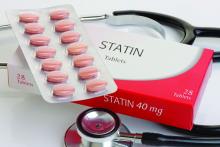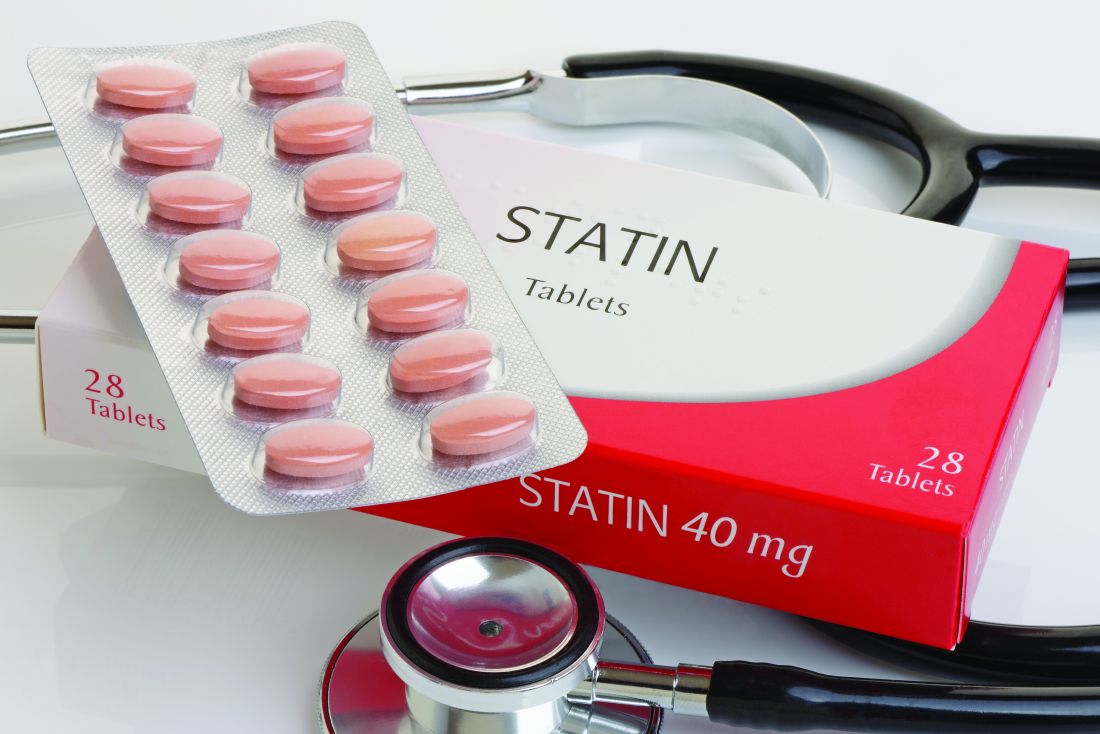User login
Only half of adults with familial hypercholesterolemia are currently on statin therapy, with even fewer receiving a high-intensity statin, according to an analysis of data from the National Health and Nutrition Examination Survey.
“We found that 0.47% of the adult U.S. population has definite/probable FH [familial hypercholesterolemia] but observed a large disconnect between screening and treatment rates in adults with definite/ probable FH and adults with severe dyslipidemia,” wrote Emily Bucholz, MD, of Boston’s Children Hospital, and her colleagues in Circulation.
The analysis found that 14 million adults, or almost 7%, in the population had severe dyslipidemia (LDL cholesterol of at least 190 mg/dL), and that 1 million of these adults, 7.2%, had definite or probable FH. Among the adults with FH, awareness and screening rates were above 80%, but those rates were only moderate among the general population. Adults who were likely to have FH were also more likely to be screened and be aware of hyperlipidemia than were those with only severe dyslipidemia.
Despite high rates of awareness, statin use was low across the board. Just over half (52% ) of patients with definite/probable FH were using a statin. The rate of statin use was even lower in patients with severe dyslipidemia, at only 38%. High-intensity statin use also dwindled in both dyslipidemia and FH patient groups (37% and 30%, respectively).
Rates of cholesterol screening, awareness, and lipid-lowering medication were particularly low in younger patients, uninsured patients, and patients without a usual source of care. Among young patients (20-39 years), 62% reported cholesterol screening in the past 5 years and 64% reported being aware of having hypercholesterolemia. Of this group, 13% were on a statin. Uninsured adults fared only slightly better, with nearly a third (29%) undergoing a recent screening and using a statin.
Limitations to the analysis include the self-reported information on cholesterol screening, awareness, treatment rates, and the lack of information concerning statin dosages.
In light of the results of this study, Dr. Bucholz emphasized that statin use among underserved patient groups without access to care needs to be a priority.
“Although rates of statin prescription have been steadily increasing over time, the rate of growth over the past decade has been slow, and there remains a significant gap in treatment rates,” wrote Dr. Bucholz and her colleagues. “Younger and uninsured adults with severe dyslipidemia in addition to those without a usual source of care are significantly less likely to be prescribed statins, highlighting the need for community-based interventions to target these adults with limited access to care.”
Apart from Sarah de Ferranti, MD, who receives research funding and royalties related to pediatric cardiology, no other authors had an relevant financial disclosures to report.
SOURCE: Bucholz EM et al. Circulation. 2018 Mar 23. doi: 10.1161/CIRCULATIONAHA.117.032321.
Only half of adults with familial hypercholesterolemia are currently on statin therapy, with even fewer receiving a high-intensity statin, according to an analysis of data from the National Health and Nutrition Examination Survey.
“We found that 0.47% of the adult U.S. population has definite/probable FH [familial hypercholesterolemia] but observed a large disconnect between screening and treatment rates in adults with definite/ probable FH and adults with severe dyslipidemia,” wrote Emily Bucholz, MD, of Boston’s Children Hospital, and her colleagues in Circulation.
The analysis found that 14 million adults, or almost 7%, in the population had severe dyslipidemia (LDL cholesterol of at least 190 mg/dL), and that 1 million of these adults, 7.2%, had definite or probable FH. Among the adults with FH, awareness and screening rates were above 80%, but those rates were only moderate among the general population. Adults who were likely to have FH were also more likely to be screened and be aware of hyperlipidemia than were those with only severe dyslipidemia.
Despite high rates of awareness, statin use was low across the board. Just over half (52% ) of patients with definite/probable FH were using a statin. The rate of statin use was even lower in patients with severe dyslipidemia, at only 38%. High-intensity statin use also dwindled in both dyslipidemia and FH patient groups (37% and 30%, respectively).
Rates of cholesterol screening, awareness, and lipid-lowering medication were particularly low in younger patients, uninsured patients, and patients without a usual source of care. Among young patients (20-39 years), 62% reported cholesterol screening in the past 5 years and 64% reported being aware of having hypercholesterolemia. Of this group, 13% were on a statin. Uninsured adults fared only slightly better, with nearly a third (29%) undergoing a recent screening and using a statin.
Limitations to the analysis include the self-reported information on cholesterol screening, awareness, treatment rates, and the lack of information concerning statin dosages.
In light of the results of this study, Dr. Bucholz emphasized that statin use among underserved patient groups without access to care needs to be a priority.
“Although rates of statin prescription have been steadily increasing over time, the rate of growth over the past decade has been slow, and there remains a significant gap in treatment rates,” wrote Dr. Bucholz and her colleagues. “Younger and uninsured adults with severe dyslipidemia in addition to those without a usual source of care are significantly less likely to be prescribed statins, highlighting the need for community-based interventions to target these adults with limited access to care.”
Apart from Sarah de Ferranti, MD, who receives research funding and royalties related to pediatric cardiology, no other authors had an relevant financial disclosures to report.
SOURCE: Bucholz EM et al. Circulation. 2018 Mar 23. doi: 10.1161/CIRCULATIONAHA.117.032321.
Only half of adults with familial hypercholesterolemia are currently on statin therapy, with even fewer receiving a high-intensity statin, according to an analysis of data from the National Health and Nutrition Examination Survey.
“We found that 0.47% of the adult U.S. population has definite/probable FH [familial hypercholesterolemia] but observed a large disconnect between screening and treatment rates in adults with definite/ probable FH and adults with severe dyslipidemia,” wrote Emily Bucholz, MD, of Boston’s Children Hospital, and her colleagues in Circulation.
The analysis found that 14 million adults, or almost 7%, in the population had severe dyslipidemia (LDL cholesterol of at least 190 mg/dL), and that 1 million of these adults, 7.2%, had definite or probable FH. Among the adults with FH, awareness and screening rates were above 80%, but those rates were only moderate among the general population. Adults who were likely to have FH were also more likely to be screened and be aware of hyperlipidemia than were those with only severe dyslipidemia.
Despite high rates of awareness, statin use was low across the board. Just over half (52% ) of patients with definite/probable FH were using a statin. The rate of statin use was even lower in patients with severe dyslipidemia, at only 38%. High-intensity statin use also dwindled in both dyslipidemia and FH patient groups (37% and 30%, respectively).
Rates of cholesterol screening, awareness, and lipid-lowering medication were particularly low in younger patients, uninsured patients, and patients without a usual source of care. Among young patients (20-39 years), 62% reported cholesterol screening in the past 5 years and 64% reported being aware of having hypercholesterolemia. Of this group, 13% were on a statin. Uninsured adults fared only slightly better, with nearly a third (29%) undergoing a recent screening and using a statin.
Limitations to the analysis include the self-reported information on cholesterol screening, awareness, treatment rates, and the lack of information concerning statin dosages.
In light of the results of this study, Dr. Bucholz emphasized that statin use among underserved patient groups without access to care needs to be a priority.
“Although rates of statin prescription have been steadily increasing over time, the rate of growth over the past decade has been slow, and there remains a significant gap in treatment rates,” wrote Dr. Bucholz and her colleagues. “Younger and uninsured adults with severe dyslipidemia in addition to those without a usual source of care are significantly less likely to be prescribed statins, highlighting the need for community-based interventions to target these adults with limited access to care.”
Apart from Sarah de Ferranti, MD, who receives research funding and royalties related to pediatric cardiology, no other authors had an relevant financial disclosures to report.
SOURCE: Bucholz EM et al. Circulation. 2018 Mar 23. doi: 10.1161/CIRCULATIONAHA.117.032321.
FROM CIRCULATION
Key clinical point: Statin use is uniformly low across multiple patient groups.
Major finding:
Study details: A cross-sectional analysis of 42,471 patients from the National Health and Nutrition Examination Survey.
Disclosures: Apart from Sarah de Ferranti, MD, who receives research funding and royalties related to pediatric cardiology, no other authors had any relevant financial disclosures to report.
Source: Bucholz EM et al. Circulation. 2018 Mar 23. doi: 10.1161/CIRCULATIONAHA.117.032321.

